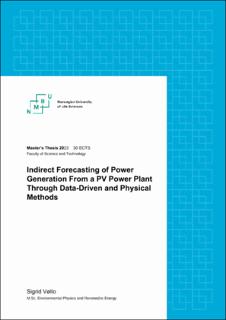| dc.description.abstract | Most people are familiar with the fact that the weather conditions are neither constant nor controllable. The power generation from photovoltaic (PV) technologies are highly dependent on the weather, thus accurate power generation forecasts are necessary if one wants knowledge about power generation hours and days ahead for PV power plants. Understanding and accurately forecasting PV power generation is also central to ensuring the stability of the electrical power system.
In this thesis, two methods, Method 1 and 2, were developed to forecast power generation with a 24-hour horizon and a 1-hour resolution for a PV power plant. In the development of the methods, three years of measurement data from a utility-scale PV power plant with an installed capacity above 100 MW were utilized. Weather forecasts from the weather forecasting service Yr and empirical data generated with the Python library pvlib were used. These data were concatenated and preprocessed with outlier detection, missing values imputation, and min-max scaling. After this, the forecasting methods were developed. These were compared to forecasts by the commercial power generation forecast provider Solargis.
Both methods in this thesis used an indirect approach where the initial step of forecasting Global Horizontal Irradiance (GHI) was equal in both methods. The GHI was forecasted with a machine learning method using Random Forest Regression (RFR). For this forecast, the input features were forecasted ambient temperature, clouds, low clouds, medium-height clouds, and precipitation, local measurements of GHI from the previous day, and historic measurements of ambient temperature and wind direction. To forecast the power generation Method 1 used the same RFR method that was used to forecast the GHI. This time, the input features were forecasts for medium clouds, wind direction, and humidity, clear sky irradiance, the GHI measurements from the previous day, and the forecasts for the GHI made in the initial step. Method 2 used a series of physical and empirical operations to calculate a forecast for power generation based on the GHI forecasts.
From the evaluation of the results, Method 1 produced the forecast with the highest skill score of 0.200. Solargis received a score of 0.122 and Method 2 0.004. In general, it was observed that Method 1 had a tendency to underestimate power generation, and Method 2 and Solargis overestimated it. It was generally seen that Method 1 had difficulties forecasting the peak generation hours. Some of the bias in the results might partially be a result of power curtailment. Because of conditions in the electrical power grid, the power generation from the PV power plant was reduced with curtailment, this was not evident in the weather data used to make the forecast in this thesis.
It was concluded that Method 1 is a viable method for power generation forecasts for PV power plants and that it has an accuracy enabling it to compete with commercial solutions. With more time to refine the method, it could become a precise and reliable tool. An accurate power generation forecast is beneficial for both the Transmission System Operator (TSO) and power plant operators for them to get better control of their operations, which can potentially result in more efficient operations for both parties. | |
